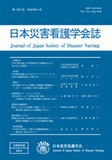Japanese
English
- 有料閲覧
- Abstract 文献概要
- 参考文献 Reference
要約
大規模災害発生時における情報伝達の速度と正確性は、災害のもたらす人的被害を軽減するための有効な一手段として挙げられる。本研究では、大規模地震に突如見舞われた地域の看護教育施設に所属する学生100人に対し、情報伝達手段と伝達内容の有効性を中心に地震発生後の緊急連絡のあり方について質問紙調査を実施した。結果として、発災翌日は連絡開始から8時間の時点で90%、発災後3日目では同時点で49%の学生しか連絡を受けていなかった。さらに全体の26.5%の学生は連絡が「遅かった」と回答した。さらに連絡内容に関して、17.7%の学生が「不十分であった」と回答している。また発災後3日間における学生の主な情報源は、テレビ63%、ラジオ23%、カーラジオ9%であった一方、テレビ・ラジオからの学校に関する情報を確認できたのは、学生全体のわずか18%であった。
大規模災害発生時の緊急連絡のあり方について、今回得られた結果をふまえて検討する。
Abstract
The rapidity and accuracy of the emergency contacts is one of the effective measures to alleviate human damage when a large-scale disaster occurs. The purpose of this study provides concise summaries of issues and resolutions in terms of the emergency contacts in a large-scale earthquake. Quantitative and qualitative designs were used: the questionnaires were given to 100 nursing students experienced the Mid Niigata Prefecture Earthquake, 2004.
From the results, 90% of students obtained emergency information from the school eight hours after the first contact had been taken place the day after the earthquake. However, only 49% of students obtained it eight hours after the first contact three days after the earthquake. Moreover, 26.5% of students pointed out that the timing of those emergency contacts was not adequate and 17.7% of students were not satisfied with all information from the school during the temporary school closure. The main information source within three days after the earthquake was TV(63%), radio(23%) and car radio(9%). Conversely, the students who were able to obtain the information about the school which had broadcasted through the TV and Radio were only 18.8%.
The effective way of the emergency crisis management in terms of communication when a large-scale earthquake occurs is discussed in the latter part of this study.
Copyright © 2006, Japan Society of Disaster Nursing All rights reserved.


